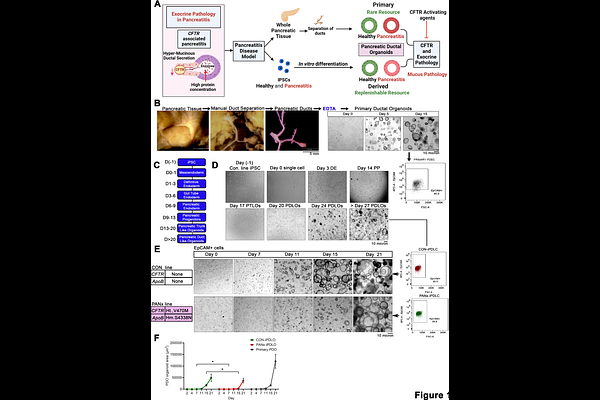Differential Expression and Microsystem Physiology Reveal Predominant and Drug Reversible CFTR-Related Defects in Idiopathic Pancreatitis

Differential Expression and Microsystem Physiology Reveal Predominant and Drug Reversible CFTR-Related Defects in Idiopathic Pancreatitis
Edirisuriya, P.; Liyanage, P.; Lee, J.; Shetty, A. J.; Liu, H.; Hutchings, D.; Freeman, A. J.; Nathan, J. D.; Appakalai, B.; Pandol, S. J.; Jegga, A. G.; Naren, A. P.; Arora, K.
AbstractPancreatitis is a potentially fatal and difficult to control exocrine-tissue defect with no FDA approved therapies to date. Variants of a chloride/bicarbonate transporter cystic fibrosis transmembrane conductance regulator (CFTR), increase the risk of pancreatitis by two- to three-fold in up to 40% of the patients. However, the relationship between the duct-restricted CFTR-function and total exocrine tissue defect during pancreatitis remains less known and animal models do not clearly translate to human disease. To overcome this challenge, we developed a robust iPSC-derived model system of pancreatic ductal tissues from an idiopathic pancreatitis patient with a common CFTR variant to understand CFTR-associated ductal tissue pancreatitis leading to the complete exocrine defect. In the patient line termed PANx, we found deficient CFTR function as well as a distinct gene expression signature for ductal tissue pancreatitis marked by aberrant mucin production, inflammatory cytokines and pancreatic neoplasms. By applying clinically used CFTR-modulator drug ivacaftor, we observed a remarkable restoration of deficient CFTR-mediated fluid secretion as well as up to 40% reversal of the differential gene signature for PANx including the reduction in mucinous neoplasms and cytokines such as IL-11, CCL20 and CXCL8 that drive immune cell infiltration during pancreatitis. We further employed a microsystem device that modeled pancreatitis-associated hyperamylasemia, a diagnostic feature of acute pancreatitis attack, due to a ductal reaction affecting acinar cell-released amylase and viability. The key mucinous signature was validated in primary pancreatitis ductal tissues with a CFTR variant. Overall, we unraveled new layers of CFTR-related pathology in pancreatitis to help us better understand the course of this debilitating condition. Additionally, the test methods and model systems discovered in this study will significantly expedite the discovery of diagnostic and therapeutic tools for treating idiopathic pancreatitis. For the first time, we provided molecular and physiologic evidence supporting the benefit of CFTR modulator drug ivacaftor in human CFTR-related pancreatitis.